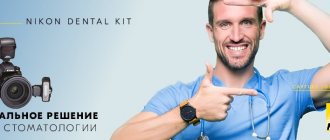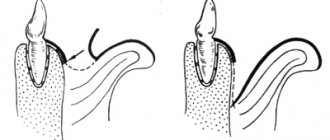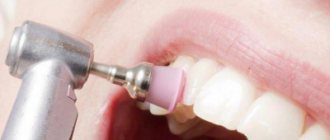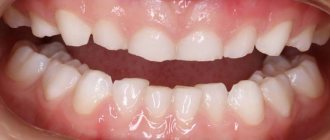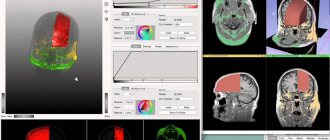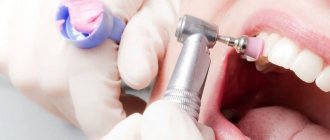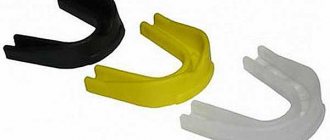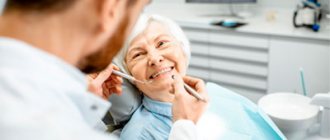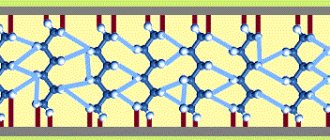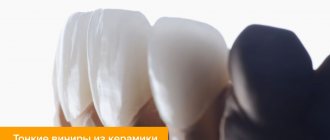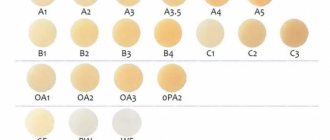Dentistry not only helps in restoring teeth, but also solves problems associated with soft tissues in the mouth. For example, when the space between the lips, teeth and gums is small. In this case, any movement of the mouth, smile, chewing process, speech, causes severe tension in the muscles and ligaments. Which leads to micro-tears and injury to the gums. And, as a result, to the appearance of problems with teeth and periodontal disease.
Vestibuloplasty in dentistry is a simple procedure for moving muscle tissue and ligaments in the oral cavity to reduce gum tension. Translated from Latin, “vestibulum” means “vestibule” - that very space between the gums and lips. The operation helps prevent such a dangerous disease as gum recession. And returns the smile to an aesthetic appearance.
It is quite difficult to independently diagnose a shallow vestibule of the mouth: discomfort in the oral cavity appears after the gums have receded. When the roots of the teeth are exposed, sensitivity to temperature changes increases. The reason for the reduction of space in front of the teeth, and the indication for the vestibuloplasty procedure, can be trauma. For example, a burn or permanent mechanical damage due to improper brushing of teeth. There are also congenital pathologies that require surgical correction.
Indications
As a rule, vestibuloplasty is prescribed before implantation, prosthetics and orthodontic treatment.
Installation of a removable denture, especially with complete edentia, is carried out only on healthy gums. Displacement or deficiency of the periodontium leads to premature wear of the orthopedic structure and injury to the mucous membrane. The vestibuloplasty procedure helps solve this problem.
Similar logic applies to the implantation process. It makes sense to implant a titanium rod only into healthy oral tissues with good blood circulation. Then the expensive structure will last a very long time. And it will become a complete replacement for a natural tooth. Both functionally and aesthetically. In this case, vestibuloplasty is indicated for successful fusion of the implant with the jawbone.
Malocclusion and problems with diction can also be associated with a small vestibule. Timely adjustment of the intraoral muscles will relieve discomfort and help achieve good results during orthodontic treatment.
Vestibuloplasty also helps eliminate external defects (unaesthetic smile, inverted lip, etc.). The sooner the patient contacts the dentist, the easier and faster the defect can be corrected. With age, the defect intensifies and becomes the cause of pathological diseases (periodontitis, periodontal disease, gum recession).
What is vestibuloplasty?
Vestibuloplasty is an operation performed to deepen the space when its size is insufficient between the outer side of the teeth and gums and the inner side of the lips and cheeks. Normally, the depth of this space in children is 4-8 mm, and after 14 years this distance should be at least 10 mm. The small size of the vestibule of the oral cavity can lead to problems of a dental and speech therapy nature, as well as cause difficulties in prosthetics or orthodontic treatment.
Possible consequences of small sizes of the vestibule of the oral cavity:
— Formation of malocclusion — Underdevelopment of the upper jaw — Excessive dental mobility — Dentofacial deformities — Speech therapy deviations
— Gum recession — Inflammatory processes of the mucous membrane of the gums — Formation of periodontal canals — Exposure of the necks and roots of teeth — Periodontal diseases – periodontitis, periodontal disease, gingivitis
The essence of vestibuloplasty is to move soft tissues and muscles in the mouth to expand the area where the gums are attached.
Contraindications
Restrictions on the operation are conventionally divided into temporary and absolute. In the first case, vestibuloplasty will be performed only after the restrictions have been eliminated. These include:
- The presence of inflammatory processes in the oral cavity.
- Colds and other respiratory diseases.
- A large percentage of teeth affected by caries.
- Sinusitis. In this case, only vestibuloplasty of the lower jaw is possible, after eliminating the acute stage of the disease.
The procedure is prohibited in case of intolerance to anesthesia, blood diseases, osteomyelitis of the jaw bone, or a predisposition to the formation of keloid scars. And also in the presence of mental illness.
Using a laser for vestibuloplasty
Vestibuloplasty using laser technologies is the most promising, innovative, minimally invasive surgical intervention. Using a laser, you can clearly predict the timing and results of plastic surgery, and clearly organize the entire treatment process.
Advantages of using laser in surgery:
- minimal impact on the nerve endings of the cut tissues, little pain;
- rapid postoperative tissue regeneration;
- precise and non-bleeding incision;
- burns of surrounding tissues are excluded, hypersensitivity of tooth enamel is not caused;
- prevention of disturbances in microcirculation processes;
- improved marginal fit of contacting surfaces;
- the possibility of infection of the operated tissues is excluded;
- destruction of pathological microflora, exclusion of purulent-destructive inflammatory processes;
- stimulation of tissue regeneration, absence of scar growths.
For vestibuloplasty, the following types of lasers are used:
- neodymium Nd:YAG laser - with good absorption in pigmented tissues (hemoglabin, melanin). Capable of cutting surfaces in continuous and pulse modes. The radiation is supplied via a flexible light guide;
- argon - with high speed and degree of polymerization of light-curing materials. When used, bleeding is effectively prevented and almost completely stopped;
- diode semiconductor laser - with good hemostatic effect and absorption by pigmented tissues. It has compact overall dimensions, is easily applicable in clinical settings, and has an effect that stimulates tissue regeneration.
Preparation for the procedure
Vestibuloplasty requires preliminary preparation. 2-3 days before surgery, the patient adheres to the recommended diet so as not to damage the mucous membrane. Immediately before the operation, 5-6 hours, you should not eat solid or tough foods. If the patient regularly takes medications, especially painkillers, it is necessary to inform the doctor in advance.
The initial stage in vestibuloplasty is hardware examination and diagnosis. Depending on the clinical situation, the doctor performs an X-ray examination or takes an image using a computed tomograph. At EspaDent clinics, for diagnostics, our specialists use a modern dental 3D tomograph Orthophos SL 3D, which takes three-dimensional, layer-by-layer images of both jaws. Accurate data helps determine the optimal treatment for each case.
Before the operation, the doctor performs professional oral hygiene. Cleans teeth from soft and hard plaque.
Operation according to Glickman
Vestibuloplasty according to Glickman is considered one of the most universal methods. It can be performed in various clinical cases, both on a small limited area and on a large area of damaged mucosa.
Interesting!
The small vestibule of the oral cavity is not always a congenital pathology. The defect can also be acquired during life under the influence of traumatic factors: burns of the mucous membrane, improper scarring of tissue as a result of surgical interventions.
Operation procedure
The vestibuloplasty procedure consists of three stages:
- Use of anesthetic. As a rule, local anesthesia (freezing effect) is used. In some cases, sedation is possible - inhaling a mixture of nitrogen and oxygen through a mask. This type of pain reliever calms, relaxes and lowers the pain threshold. It has no side effects, so it is often used in children's treatment.
- The surface of the gums is treated with a disinfectant. Then the doctor makes incisions and adjusts the position of the oral muscles and ligaments.
- The vestibuloplasty procedure ends with suturing.
Additionally, the dentist fixes a bandage with antiseptics and medications on the seams. After the operation, the patient is given recommendations for oral care.
Operation Clark
This method is one of the simplest. It is used mainly to correct defects in the upper jaw. The procedure is performed under anesthesia, most often under infiltration, so there is no need to be afraid of pain during the operation.
During the procedure, the doctor cuts through the tissue between the mucous membrane of the inner lip and gum. Then the specialist peels off or lifts the mucous membrane. Then it displaces the tendons and muscles located underneath it to the required depth. Next, the mucosa is fixed to the periosteum by suturing.
This is what the Clark operation looks like
Important!
Six hours before surgery, avoid eating solid foods. Strictly follow all doctor's recommendations: painkillers, alcohol or sedatives taken at home can adversely affect your body and the effect of anesthetics.
Techniques
Based on the type of mucosal preparation, vestibuloplasty is divided into closed and open. The Clark method is used to cut and move the soft tissues of the upper jaw. Plastic surgery allows you to make deep incisions without damaging bone tissue. The basis of the method is dissection of the area where the mobile mucosa connects to the gum. Then the upper layer of the mucous membrane of the lip is carefully peeled off, and the muscle tissue moves deeper into the vestibule of the mouth. At the final stage, the separated section of the mucosa is fixed on the periosteum.
For mandibular vestibuloplasty, the Edlan-Meicher method is used. The stages of the operation are similar to the previous method. A deep incision is made along the lower jaw contour. The rehabilitation period is from two weeks to a month.
Plastic surgery according to Glickman allows you to correct both jaws, with an incision at the place of attachment of the lip up to 1.5 cm deep. The technique according to Schmidt is also applicable to both jaws. However, there is no detachment of the upper layer of the mucous membrane. The edges of the flap are moved inward and sutures are applied.
Tunnel vestibuloplasty is characterized by gentle surgical intervention and a short rehabilitation period (no more than two weeks). During the operation, the doctor makes three incisions. Two horizontal, parallel to the dentition. And one vertical, parallel to the bridle.
Vestibuloplasty in Moscow: price
| — Vestibuloplasty | 6500 rub. |
| — Primary surgical treatment with suturing | 1000 rub. |
| — Manufacturing of a protective plate | 8000 rub. |
| — Collection of connective tissue graft | 4000 rub. |
| — Infiltration and intraligamentary anesthesia | 350 rub. |
| — Conduction anesthesia | 400 rub. |
View price list
Laser Application
In the traditional procedure, all surgical incisions are made using a scalpel. This is a classic, proven technique that has been around for many years. However, the trauma rate due to mechanical impact is much higher than when using hardware technologies.
Laser vestibuloplasty significantly reduces the recovery period. During the incision, the laser instantly cauterizes the tissue, preventing bleeding and swelling. The device allows you to make more precise and accurate cuts. Which promotes rapid healing of wounds and a more aesthetic appearance.
How to treat emerging complications
Ignoring rehabilitation recommendations can lead to the occurrence of certain pathologies, namely:
- severe bleeding. To eliminate it, you should use hemostatic tablets, make cold applications with liquids for better blood clotting;
- the appearance of ligature fistulas. May be caused by individual intolerance to suture material. In this case, you should consult a doctor to prescribe healing medications;
- excessive swelling. It may be an individual feature; as a rule, it completely disappears within 3-5 days from the date of surgery;
- loss of sensation in the operated area. The norm is that the period of complete restoration of sensitivity can range from six months to 9 months. Physiotherapy (hydromassage, paraffin baths) and rehabilitation exercises help speed up the process.
Sources used:
- Surgical dentistry: Textbook for medical dental institutes / A. I. Evdokimov, I. G. Lukomsky, I. M. Starobinsky; With the participation of Associate Professor G. A. Vasiliev and Professor M. B. Fabrikant. - M.: Medgiz, 1950.
- National Library of Medicine (USA)
- “Outpatient surgical dentistry” (Bezrukov V.)
- “Propaedeutics of surgical dentistry” (Soloviev M.)
Postoperative period
In the first 2-3 days after vestibuloplasty, the vestibule of the mouth is very sensitive to any external influences. To avoid damaging the sutures and wound surface, it is not recommended to brush your teeth or rinse your mouth excessively. To relieve swelling, light rinsing and compresses using antiseptics and herbal infusions are recommended. After the operation, the doctor will write out detailed instructions.
Also during the rehabilitation period it is necessary to follow a special diet. During the healing period of soft tissues, it is important to exclude hard, too hot or cold foods, alcohol, and dairy products from the diet.
To speed up the regenerative processes after vestibuloplasty, massage of the outer skin in the area of the incisions is recommended. And also inflating the cheeks, including in the area of the vestibule of the mouth with a delay of 1-2 minutes.
During rehabilitation, it is important to visit a doctor in a timely manner to monitor the state of recovery processes. Visits to the dentist are necessary every 2-3 months.
What complications can there be?
Vestibuloplasty is considered a relatively simple operation, which is practically not accompanied by serious complications. However, they cannot be excluded, especially if the patient neglects the doctor’s recommendations during the rehabilitation period. Ideally, consequences such as tissue bleeding, swelling and pain reach their peak on the second day after surgery, then begin to subside. Sometimes, negligence on the part of the patient can lead to the formation of scars, purulent inflammations and fistulas, and relapse of the disease (the probability of complications is only 0.1 percent).
“I needed vestibuloplasty in order to properly fix the prosthesis; there was not enough space. The procedure was very difficult for me, although there were no special complications, but the rehabilitation period was extremely long and protracted. The discomfort continued for 8 months. But what’s most unpleasant is that removable dentures didn’t bring much joy after that either. It would be better to immediately decide on implantation, as the doctor advised, a prosthesis on implants takes up much less space, and there would be no need to operate on me on such a large scale.”
Ekaterina Mikhailovna, Moscow, from correspondence on forums
Indications and contraindications for vestibuloplasty
The procedure has a wide list of indications. It is carried out to treat existing diseases, prevent the development of pathologies, improve the quality of speech, and for aesthetic reasons. Used in pediatric and adult dentistry. Adult patients can be prescribed before prosthetics.
The operation is prescribed for:
- stable fixation of implants, prostheses (carried out before orthodontic treatment);
- prevention of gum recession in chronic periodontitis, gingivitis, as well as in anatomical abnormalities;
- correction of speech defects, complicated phonation, sound production disorders;
- elimination of cosmetic defects caused by increased tone of the mental muscles and the small vestibule of the mouth.
Surgical intervention is contraindicated in cases of extensive caries, osteomyelitis, a tendency to tissue scarring (cellagenosis, keloid scars), malignant formations, radiation therapy in the neck and head, coagulation disorders, blood cancer, diabetes mellitus in the stage of decompensation, severe pathologies of the heart and blood vessels, mental disorders, chronic alcoholism and drug addiction.
If the restrictions are temporary, then the procedure is done after the obstacles have been removed. In case of absolute contraindications, the dentist looks for alternative ways to solve the problem.
How is mandibular vestibuloplasty done: stages of the procedure
The operation is performed by a dental surgeon. A preliminary examination and identification of contraindications is carried out. The doctor determines the method of anesthesia. On the day of the procedure, you need to avoid solid foods, which can damage the mucous membranes of the mouth. It is necessary to thoroughly brush your teeth to remove plaque. You should not take medications without prior approval from your doctor.
The surgical intervention is carried out in several stages:
- Anesthesia. The use of local anesthetics is usually sufficient. For children and according to indications, pain relief is possible using sedation or anesthesia.
- Antiseptic treatment of the operated area. Dissection of the mucous membranes using the chosen method and detachment of the flap. Moving submucosal tissues (muscle fibers, tendons) to the desired depth. Fixation of the mucosal flap to the periosteum.
- Applying a dental bandage to the wound area and a fixing pressure bandage to the chin. Applying dry ice to relieve swelling. Cooling compresses can be done at home.
You can see how patchwork vestibuloplasty surgery is performed (photos, videos) on the Internet. After surgical manipulations, swelling appears, and after the anesthesia wears off, pain appears. Such manifestations are normal and can last up to several days. To relieve acute symptoms, you can take analgesics and apply ice.
How much will the treatment cost?
The average cost of the procedure is about 6 thousand rubles. The exact price will depend on the volume of work to be done, as well as the technology used. Thus, a Schmitd operation using a standard scalpel will cost about 3 thousand rubles. A similar procedure using laser equipment will cost up to 10 thousand rubles.
Complications after vestibuloplasty most often arise due to the fault of the patients themselves, due to insufficient oral care during the rehabilitation period, or non-compliance with doctor’s recommendations. If bleeding and swelling do not go away, but only intensify, it is better to immediately consult a specialist - this will eliminate or promptly stop the development of inflammatory processes.
1Borodulina I.I. Vestibuloplasty in the complex treatment of periodontal diseases, 2005.
